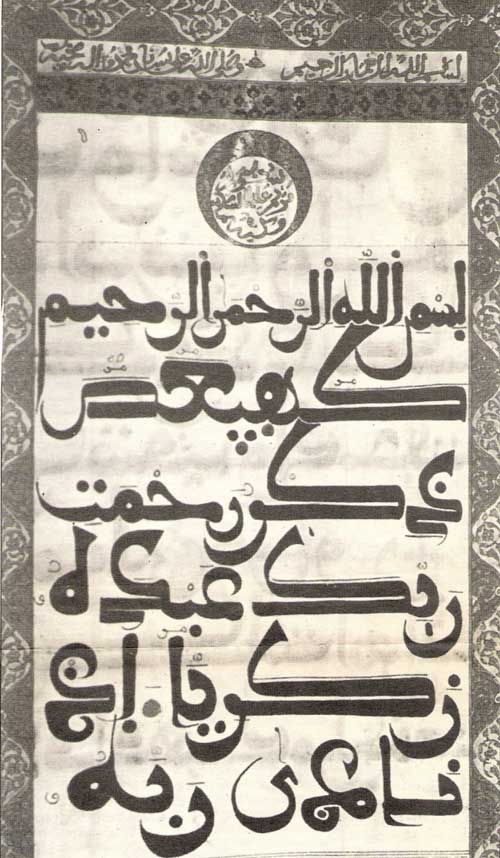History
For the purposes of calli¬graphy Caliph Abdel Malik (685-705) divided Arabic script into two distinct schools: Kufic, an angular rigid script good for carving and ornamen¬tal texts and Naskhi, a more rounded flowing cursive script for everyday use.
Different uses demanded different styles; one for administration, one for poetry etc..., so from these two main styles came many others. The book industry that emer¬ged after the birth of calligraphy required a whole range of spe¬cialists including the goldsmith, illuminator, calligrapher and binder.
A Sura of the Qur’an says that "he who gives us the word, follows it." As soon as the Caliph Othman began writing the text of the 'Revealed word of the Prophet' in 650 the Arabic language, the mainstay of the Qur’anic revelations, became a source of artistic inspiration. Since then the Qur’an has remained inextricably linked to the Arabic lettering. The oldest Qur’an in existence is from the eighth century and written in a pronounced cursive called al-ma’il (the slanting).
By the ninth century Kufic had become the most frequently used script by calligraphers and quickly developed regional variations. The one-handed cal¬ligrapher Ibn Moqla instituted the first code of calligraphy, 'Precis of Calligraphy' . A copy dating from 1663 can be found at the National Library in Cairo.
Parchments from manus¬cripts found in Kairouan are mostly pages from incomplete or dispersed Qur’ans, the different types of Kufic calligraphy and most of the ornamental motifs being iden¬tical to those found in Yemen, Egypt and Istanbul in the same era. The preferred script of the calligraphers of Kairouan was a strong black or gold Kufic with short verticals and elon¬gated horizontals: This style spread throughout North Africa. Due to the structure of this script Koran's came to be written on long shallow pages. The Bedouin invasion of the eleventh century destroyed the scholastic life of Kairouan. A form of script originating from the government secretaries of Moorish Spain, a mix of Kufic and cursive with deep flouris¬hes below the line and a rigid principal horizontal line became popular in the Almo¬had’s (al-Muwahudun) rule and lasted until the eighteenth century.
Outside of North Africa many other scripts were used. The variety of tones of Mana¬chir script could indicate repri¬mand or satisfaction even before the first letter was read. Ghober ('dust') was a minia¬ture script specifically for pigeon post and tiny Qur’ans --¬ some so small they could be hidden under a signet ring. The invention of the printing press in the eighteenth century arres¬ted further development.
Calligraphy and the Arabic alphabet
Arabic is derived from Aramaic writing which in turn comes from Phoenician. The alphabet has 28 letters, all consonants. To indicate vowels certain ticks are used above and below the line. In the past these ticks were in red so as not to confuse vowels with black diacritic points, dots placed above or below a letter to differentiate letters of a simi¬lar shape. Each letter can take four different forms according to whether it is isolated, at the beginning, middle or end of a phrase.
The Arabic letters are used for numerous other languages, notably Persian. The spread of Islam played an important role in the diffusion of the Arabic script.
The symbols used by calligraphers became progressively more complex and decorative, an endless knot in gold marking the end of a verse. At the end of every five verses was a teardrop. The Qur’an is divided into sixty parts for the purposes of recitation. An almond shape indicated the end of one of the sixty sections to the reader. A domed square showed a vital passage that required a prostration from the narrator.
Materials
The script was traditionally written in black ink made with the burnt wool from a sheep's belly and was written with a pen made from 24 donkey hairs often substituted with dried reed. For marriage documents a red copper pen was used, for letters to friends a silver or stork beak pen, for letters to enemies a sliver of pomegranate.
The material on which the calligraphy was written also of great importance. Qur’ans writ¬ten on parchment were not available to everyone so enor¬mous calligraphs were sculpted on stones, on the walls of mosques so as to be visible to all, allowing calligraphy to become part of everyday life. Other materials included glass, cloth, wood, ceramic, metal, leather, palm leaves, camel bones, pottery shards, papyrus (made of slices of river reeds), wooden blocks and, primarily, parchment. To make parch¬ment a goat or sheep was sacri¬ficed according to Islamic rites and the skin treated and dried to be used for a Qur’an . The first paper maker (a Chinese inven¬tion) installed himself in Bagh¬dad in 794 under Haroun ar-Rashid.
The traditional position for a calligrapher is sitting on the ground. He writes directly on his knee or on a low table. The calligrapher prepares the ink with a particular and sometimes secret recipe. Arabic gum, black dust from smoke, iron sulphate, pestle and mortar, and natural sponge which he placed at the bottom of the inkwell.
Source: Tunisia News, 1996


